A Review of Point Cloud Registration Algorithms for Laser Scanners: Applications in Large-Scale Aircraft Measurement
Abstract
:1. Introduction
2. Registration Algorithms Based on Hierarchical Optimization
2.1. Iterative Closest Point (ICP)-Based
2.2. Graph Matching (GM)-Based
3. Registration Algorithms Based on Probability Stochastic Distribution Model
3.1. Random Sample Consensus (RANSAC)-Based
3.2. Normal Distribution Transform (NDT)-Based
3.3. Gaussian Mixture Model (GMM)-Based
4. Registration Algorithms Based on Feature
4.1. Feature Extraction
4.2. Feature Matching
5. Application in Large-Scale Aircraft Measurement
6. Conclusions and Future Research
Author Contributions
Funding
Institutional Review Board Statement
Informed Consent Statement
Data Availability Statement
Conflicts of Interest
References
- Liang, X.; Litkey, P.; Hyyppa, J.; Kaartinen, H.; Vastaranta, M.; Holopainen, M. Image-guided registration of unordered terrestrial laser scanning point clouds for urban scenes. IEEE Trans. Geosci. Remote 2012, 50, 661–670. [Google Scholar] [CrossRef]
- Kelbe, D.; van Aardt, J.; Romanczyk, P.; van Leeuwen, M.; Cawse-Nicholson, K. Marker-Free Registration of Forest Terrestrial Laser Scanner Data Pairs with Embedded Confidence Metrics. IEEE Trans. Geosci. Remote Sens. 2016, 54, 4314–4330. [Google Scholar] [CrossRef]
- Polewski, P.; Yao, W.; Heurich, M.; Krzystek, P.; Stilla, U. Learning a constrained conditional random field for enhanced segmentation of fallen trees in ALS point clouds. ISPRS J. Photogramm. Remote Sens. 2018, 140, 33–44. [Google Scholar] [CrossRef]
- Jaboyedoff, M.; Oppikofer, T.; Abellan, A.; Derron, M.H.; Loye, A.; Metzger, R.; Pedrazzini, A. Use of LIDAR in landslide investigations: A review. Nat. Hazards 2012, 61, 5–28. [Google Scholar] [CrossRef] [Green Version]
- Barbarella, M.; Fiani, M.; Lugli, A. Landslide monitoring using multitemporal terrestrial laser scanning for ground displacement analysis. Geomat. Nat. Hazards Risk 2013, 6, 398–418. [Google Scholar] [CrossRef]
- Özdoğan, M.V.; Deliormanlı, A.H. Determination of possible failure surfaces in an open-pit slope caused by underground production. B Geofis. Teor. Appl. 2020, 61, 199–218. [Google Scholar] [CrossRef]
- Özdoğan, M.V.; Deliormanlı, A.H. Landslide detection and characterization using terrestrial 3D laser scanning (LiDAR). Acta Geodyn. Geomater. 2019, 16, 379–392. [Google Scholar] [CrossRef] [Green Version]
- Derron, M.-H.; Jaboyedoff, M. Preface LIDAR and DEM techniques for landslides monitoring and characterization. Nat. Hazards Earth Syst. Sci. 2010, 10, 1877–1879. [Google Scholar] [CrossRef]
- Guerriero, L.; Revellino, P.; Luongo, A.; Focareta, M.; Grelle, G.; Guadagno, F.M. The Mount Pizzuto earth flow: Deformational pattern and recent thrusting evolution. J. Maps 2016, 12, 1187–1194. [Google Scholar] [CrossRef] [Green Version]
- Travelletti, J.; Malet, J.-P.; Delacourt, C. Image-based correlation of Laser Scanning point cloud time series for landslide monitoring. Int. J. Appl. Earth Obs.Geoinf. ITC J. 2014, 32, 1–18. [Google Scholar] [CrossRef]
- Prokop, A.; Panholzer, H. Assessing the capability of terrestrial laser scanning for monitoring slow moving landslides. Nat. Hazards Earth Syst. Sci. 2009, 9, 1921–1928. [Google Scholar] [CrossRef] [Green Version]
- Huang, R.; Ye, Z.; Boerner, R.; Yao, W.; Xu, Y.; Stilla, U. Fast pairwise coarse registration between point clouds of construction sites using 2d projection-based phase correlation. ISPRS—Int. Arch. Photogramm. Remote Sens. Spat. Inf. Sci. 2019, XLII-2/W13, 1015–1020. [Google Scholar] [CrossRef] [Green Version]
- Calders, K.; Adams, J.; Armston, J.; Bartholomeus, H.; Bauwens, S.; Bentley, L.P.; Chave, J.; Danson, F.M.; Demol, M.; Disney, M.; et al. Terrestrial laser scanning in forest ecology: Expanding the horizon. Remote Sens. Environ. 2020, 251, 112102. [Google Scholar] [CrossRef]
- Weiser, H.; Schäfer, J.; Winiwarter, L.; Krašovec, N.; Fassnacht, F.E.; Höfle, B. Individual tree point clouds and tree measurements from multi-platform laser scanning in German forests. Earth Syst. Sci. Data 2022, 14, 2989–3012. [Google Scholar] [CrossRef]
- Tao, S.; Labrière, N.; Calders, K.; Fischer, F.J.; Rau, E.-P.; Plaisance, L.; Chave, J. Mapping tropical forest trees across large areas with lightweight cost-effective terrestrial laser scanning. Ann. For. Sci. 2021, 78, 103. [Google Scholar] [CrossRef]
- Næsset, E.; Gobakken, T.; Holmgren, J.; Hyyppä, H.; Hyyppä, J.; Maltamo, M.; Nilsson, M.; Olsson, H.; Persson, A.; Söderman, U. Laser scanning of forest resources: The nordic experience. Scand. J. For. Res. 2004, 19, 482–499. [Google Scholar] [CrossRef]
- Morgan, M.; Habib, A. Interpolation of lidar data and automatic building extraction. In Proceedings of the ACSM-ASPRS Annual Conference, Washington, DC, USA, 19–26 April 2002; pp. 432–441. [Google Scholar]
- Oesau, S.; Lafarge, F.; Alliez, P. Indoor scene reconstruction using feature sensitive primitive extraction and graph-cut. ISPRS J. Photogramm. Remote Sens. 2014, 90, 68–82. [Google Scholar] [CrossRef] [Green Version]
- Dong, Z.; Yang, B.; Hu, P.; Scherer, S. An efficient global energy optimization approach for robust 3D plane segmentation of point clouds. ISPRS J. Photogramm. Remote Sens. 2018, 137, 112–133. [Google Scholar] [CrossRef]
- Montuori, A.; Luzi, G.; Stramondo, S.; Casula, G.; Bignami, C.; Bonali, E.; Bianchi, M.G.; Crosetto, M. Combined use of ground-based systems for Cultural Heritage conservation monitoring. In Proceedings of the 2014 IEEE Geoscience and Remote Sensing Symposium, Quebec City, QC, Canada, 13–18 July 2014; IEEE: Quebec City, QC, Canada, 2014; pp. 4086–4089. [Google Scholar] [CrossRef]
- Emam, S.; Khatibi, S.; Khalili, K. Improving the Accuracy of Laser Scanning for 3D Model Reconstruction Using Dithering Technique. Procedia Technol. 2014, 12, 353–358. [Google Scholar] [CrossRef]
- Boardman, C.; Bryan, P.; McDougall, L.; Reuter, T.; Payne, E.; Moitinho, V.; Rodgers, T.; Honkova, J.; O’Connor, L.; Blockley, C.; et al. 3D Laser Scanning for Heritage. Advice and Guidance on the Use of Laser Scanning in Archaeology and Architecture; Historic England: Swindon, UK, 2018. [Google Scholar]
- Wu, C.; Yuan, Y.; Tang, Y.; Tian, B. Application of Terrestrial Laser Scanning (TLS) in the Architecture, Engineering and Construction (AEC) Industry. Sensors 2021, 22, 265. [Google Scholar] [CrossRef]
- Yin, Y.; Antonio, J. Application of 3D laser scanning technology for image data processing in the protection of ancient building sites through deep learning. Image Vis. Comput. 2020, 102, 103969. [Google Scholar] [CrossRef]
- Huo, P.; Hou, M.; Dong, Y.; Li, A.; Ji, Y.; Li, S. A Method for 3D Reconstruction of the Ming and Qing Official-Style Roof Using a Decorative Components Template Library. ISPRS Int. J. Geo-Inf. 2020, 9, 570. [Google Scholar] [CrossRef]
- Pomerleau, F.; Colas, F.; Siegwart, R. A Review of Point Cloud Registration Algorithms for Mobile Robotics. Found. Trends® Robot. 2013, 4, 1–104. [Google Scholar] [CrossRef] [Green Version]
- Díez, Y.; Roure, F.; Lladó, X.; Salvi, J. A Qualitative Review on 3D Coarse Registration Methods. ACM Comput. Surv. 2015, 47, 1–36. [Google Scholar] [CrossRef]
- Cheng, L.; Chen, S.; Liu, X.; Xu, H.; Wu, Y.; Li, M.; Chen, Y. Registration of Laser Scanning Point Clouds: A Review. Sensors 2018, 18, 1641. [Google Scholar] [CrossRef] [Green Version]
- Dong, Z.; Liang, F.; Yang, B.; Xu, Y.; Zang, Y.; Li, J.; Wang, Y.; Dai, W.; Fan, H.; Hyyppä, J.; et al. Registration of large-scale terrestrial laser scanner point clouds: A review and benchmark. ISPRS J. Photogramm. Remote Sens. 2020, 163, 327–342. [Google Scholar] [CrossRef]
- Huang, X.; Mei, G.; Zhang, J.; Abbas, R. A comprehensive survey on point cloud registration. arXiv 2021, arXiv:2103.02690v2. [Google Scholar]
- Besl, P.J.; McKay, N.D. A method for registration of 3-D shapes. IEEE Trans. Pattern Anal. Mach. Intell. 1992, 14, 239–256. [Google Scholar] [CrossRef] [Green Version]
- Blais, G.; Levine, M. Registering multiview range data to create 3D computer objects. IEEE Trans. Pattern Anal. Mach. Intell. 1995, 17, 820–824. [Google Scholar] [CrossRef] [Green Version]
- Pulli, K. Multiview registration for large data sets. In Proceedings of the Second International Conference on 3D Digital Imaging and Modeling, Ottawa, Canada, 4–8 October 1999; pp. 160–168. [Google Scholar]
- Rusinkiewicz, S.; Levoy, M. Efficient variants of the ICP algorithm. In Proceedings of the 3rd International Conference on 3-D Digital Imaging and Modeling, Quebec City, Canada, 28 May–1 June 2001; pp. 145–152. [Google Scholar]
- Sharp, G.; Lee, S.; Wehe, D. ICP registration using invariant features. IEEE Trans. Pattern Anal. Mach. Intell. 2002, 24, 90–102. [Google Scholar] [CrossRef]
- Fitzgibbon, A.W. Robust Registration of 2D and 3D Point Sets. Image Vis. Comput. 2003, 21, 1134–1153. [Google Scholar] [CrossRef]
- Bae, K.H.; Lichti, D.D. A method for automated registration of unorganized point clouds. ISPRS J. Photogramm. 2008, 63, 36–54. [Google Scholar] [CrossRef]
- Censi, A. An ICP variant using a point-to-line metric. In Proceedings of the IEEE International Conference on Robotics and Automation, Pasadena, CA, USA, 19–23 May 2008; pp. 19–25. [Google Scholar]
- Segal, A.; Haehnel, D.; Thrun, S. Generalized-ICP. In Robotics: Science and Systems; University of Washington: Seattle, WA, USA, 2009. [Google Scholar]
- Ying, S.; Peng, J.; Du, S.; Qiao, H. A Scale Stretch Method Based on ICP for 3D Data Registration. IEEE Trans. Autom. Sci. Eng. 2009, 6, 559–565. [Google Scholar] [CrossRef]
- Bouaziz, S.; Tagliasacchi, A.; Pauly, M. Sparse Iterative Closest Point. Comput. Graph. Forum 2013, 32, 113–123. [Google Scholar] [CrossRef] [Green Version]
- Yang, J.; Li, H.; Campbell, D.; Jia, Y. Go-ICP: A Globally Optimal Solution to 3D ICP Point-Set Registration. IEEE Trans. Pattern Anal. Mach. Intell. 2015, 38, 2241–2254. [Google Scholar] [CrossRef] [Green Version]
- He, Y.; Liang, B.; Yang, J.; Li, S.; He, J. An Iterative Closest Points Algorithm for Registration of 3D Laser Scanner Point Clouds with Geometric Features. Sensors 2017, 17, 1862. [Google Scholar] [CrossRef] [Green Version]
- Wang, Y.; Solomon, J. Deep Closest Point: Learning Representations for Point Cloud Registration. In Proceedings of the IEEE International Conference on Computer Vision and Pattern Recognition, Long Beach, CA, USA, 16–17 June 2019; pp. 3522–3531. [Google Scholar]
- Wang, Y.; Solomon, J.M. PRNet: Self-Supervised Learning for Partial-to-Partial Registration. In Proceedings of the 33rd Conference on Neural Information Processing Systems, Online, 6–12 December 2020; Volume 32. [Google Scholar]
- Koide, K.; Yokozuka, M.; Oishi, S.; Banno, A. Voxelized GICP for Fast and Accurate 3D Point Cloud Registration. In Proceedings of the IEEE International Conference on Robotics and Automation, Xi’an, China, 30 May–5 June 2021; pp. 11054–11059. [Google Scholar]
- Umeyama, S. An eigen decomposition approach to weighted graph matching problems. IEEE Trans. Pattern Anal. 1988, 10, 695–703. [Google Scholar] [CrossRef]
- Luo, B.; Hancock, E. Structural graph matching using the EM algorithm and singular value decomposition. IEEE Trans. Pattern Anal. Mach. Intell. 2001, 23, 1120–1136. [Google Scholar] [CrossRef]
- Caelli, T.; Kosinov, S. An eigenspace projection clustering method for inexact graph matching. IEEE Trans. Pattern Anal. Mach. Intell. 2004, 26, 515–519. [Google Scholar] [CrossRef]
- Leordeanu, M.; Hebert, M. A spectral technique for correspondence problems using pairwise constraints. In Proceeding of the Tenth IEEE International Conference on Computer Vision (ICCV’05), Beijing, China, 17–21 October 2005; p. 1482. [Google Scholar] [CrossRef]
- Cour, T.; Srinivasan, P.; Shi, J. Balanced graph matching. In Proceedings of the Conference on Advances in Neural Information Processing Systems, Vancouver, BC, Canada, 4–7 December 2006; pp. 313–320. [Google Scholar]
- Gold, S.; Rangarajan, A. A graduated assignment algorithm for graph matching. IEEE Trans. Pattern Anal. Mach. Intell. 1996, 18, 377–388. [Google Scholar] [CrossRef] [Green Version]
- Torresani, L.; Kolmogorov, V.; Rother, C. Feature Correspondence Via Graph Matching: Models and Global Optimization. In Proceedings of the European Conference on Computer Vision, Marseille, France, 12–18 October 2008; Springer: Berlin/Heidelberg, Germany, 2008; Volume 61, pp. 255–265. [Google Scholar]
- Zhou, F.; de la Torre, F. Factorized Graph Matching. In Proceedings of the IEEE Conference on Computer Vision and Pattern Recognition, Las Vegas, NV, USA, 27–30 June 2016; Volume 38, pp. 1774–1789. [Google Scholar]
- Jiang, B.; Tang, T.; Cao, X.C.; Luo, B. Lagrange relaxation graph matching. Pattern Recogn. 2017, 61, 255–265. [Google Scholar] [CrossRef]
- Fu, K.; Liu, S.; Luo, X.; Wang, M. Robust Point Cloud Registration Framework Based on Deep Graph Matching. In Proceedings of the IEEE Conference on Computer Vision and Pattern Recognition, Nashville, TN, USA, 20–25 June 2021; pp. 8889–8898. [Google Scholar]
- Chaudhury, K.N.; Khoo, Y.; Singer, A. Global Registration of Multiple Point Clouds Using Semidefinite Programming. SIAM J. Optim. 2015, 25, 468–501. [Google Scholar] [CrossRef] [Green Version]
- Maron, H.; Dym, N.; Kezurer, I.; Kovalsky, S.; Lipman, Y. Point registration via efficient convex relaxation. ACM Trans. Graph. 2016, 35, 1–12. [Google Scholar] [CrossRef]
- Le, H.M.; Do, T.-T.; Hoang, T.; Cheung, N.-M. SDRSAC: Semidefinite-Based Randomized Approach for Robust Point Cloud Registration Without Correspondences. In Proceedings of the IEEE Conference on Computer Vision and Pattern Recognition, Long Beach, CA, USA, 16–20 June 2019; pp. 124–133. [Google Scholar]
- Yang, H.; Shi, J.; Carlone, L. TEASER: Fast and Certifiable Point Cloud Registration. IEEE Trans. Robot. 2020, 37, 314–333. [Google Scholar] [CrossRef]
- Sun, L. IRON: Invariant-based highly robust point cloud registration. arXiv 2022, arXiv:2103.04357. [Google Scholar]
- Zass, R.; Shashua, A. Probabilistic graph and hypergraph matching. In Proceedings of the IEEE Conference on Computer Vision and Pattern Recognition, Anchorage, AK, USA, 24–26 June 2008; pp. 1–8. [Google Scholar]
- Duchenne, O.; Bach, F.; Kweon, I.-S.; Ponce, J. A Tensor-Based Algorithm for High-Order Graph Matching. IEEE Trans. Pattern Anal. Mach. Intell. 2011, 33, 2383–2395. [Google Scholar] [CrossRef] [Green Version]
- Lee, J.; Cho, M.; Lee, K.M. Hyper-graph matching via reweighted random walks. In Proceedings of the IEEE Conference on Computer Vision and Pattern Recognition, Colorado Springs, CO, USA, 20–25 June 2011; pp. 1633–1640. [Google Scholar]
- Ngoc, Q.N.; Gautier, A.; Hein, M. A flexible tensor block coordinate ascent scheme for hypergraph matching. In Proceedings of the IEEE Conference on Computer Vision and Pattern Recognition, Boston, MA, USA, 7–12 June 2015; pp. 5270–5278. [Google Scholar]
- Zhang, R.; Wang, W. Second- and High-Order Graph Matching for Correspondence Problems. IEEE Trans. Circuits Syst. Video Technol. 2018, 28, 2978–2992. [Google Scholar] [CrossRef]
- Pavlov, A.L.; Ovchinnikov, G.W.; Derbyshev, D.Y.; Tsetserukou, D.; Oseledets, I.V. AA-ICP: Iterative Closest Point with Anderson Acceleration. In Proceedings of the 2018 IEEE International Conference on Robotics and Automation (ICRA), Brisbane, QLD, Australia, 21–25 May 2018; pp. 3407–3412. [Google Scholar] [CrossRef] [Green Version]
- Li, G.; Cui, Y.; Wang, L.; Meng, L. Automatic Registration Algorithm for the Point Clouds Based on the Optimized RANSAC and IWOA Algorithms for Robotic Manufacturing. Appl. Sci. 2022, 12, 9461. [Google Scholar] [CrossRef]
- Loiola, E.M.; de Abreu, N.M.M.; Boaventura-Netto, P.O.; Hahn, P.; Querido, T. A survey for the quadratic assignment problem. Eur. J. Oper. Res. 2007, 176, 657–690. [Google Scholar] [CrossRef]
- Tian, Y.; Yan, J.; Zhang, H.; Zhang, Y.; Yang, X.; Zha, H. On the Convergence of Graph Matching: Graduated Assignment Revisited. In Proceedings of the 12th European Conference on Computer Vision, Florence, Italy, 7–13 October 2012; Volume 7574, pp. 821–835. [Google Scholar]
- Lai-Dang, Q.-V.; Nengroo, S.H.; Jin, H. Learning Dense Features for Point Cloud Registration Using a Graph Attention Net-work. Appl. Sci. 2022, 12, 7023. [Google Scholar] [CrossRef]
- Fischler, M.A.; Bolles, R.C. Random Sample Consensus: A Paradigm for Model Fitting with Applications to Image Analysis and Automated Cartography. Commun. ACM 1981, 24, 381–395. [Google Scholar] [CrossRef]
- Myatt, D.R.; Torr, P.H.S.; Nasuto, S.J.; Bishop, J.M.; Craddock, R. NAPSAC: High noise, high dimensional robust estimation-It’s in the bag. In Proceedings of the British Machine Vision Conference, Cardiff, UK, 2–5 September 2002; pp. 458–467. [Google Scholar]
- Chum, O.; Matas, J.; Kittler, J. Locally optimized RANSAC. Pattern Recogn. Proc. 2003, 2781, 236–243. [Google Scholar]
- Chum, O.; Matas, J. Matching with PROSAC-Progressive Sample Consensus. In Proceedings of the IEEE Conference on Computer Vision and Pattern Recognition, San Diego, CA, USA, 20–25 June 2005; pp. 220–226. [Google Scholar]
- Ma, S.; Ma, X.; You, H.; Tang, T.; Wang, J.; Wang, M. SC-PROSAC: An Improved Progressive Sample Consensus Algorithm Based on Spectral Clustering. In Proceedings of the 3rd International Conference on Robotics and Computer Vision, Beijing, China, 6–8 August 2021; pp. 73–77. [Google Scholar]
- Aiger, D.; Mitra, N.J.; Cohen-Or, D. 4-points congruent sets for robust pairwise surface registration. ACM Trans. Graph. 2008, 27, 1–10. [Google Scholar] [CrossRef] [Green Version]
- Mellado, N.; Aiger, D.; Mitra, N.J. Super 4PCS: Fast global point cloud registration via smart indexing. Comput. Graph. Forum 2015, 33, 205–215. [Google Scholar] [CrossRef] [Green Version]
- Sattler, T.; Leibe, B.; Kobbelt, L. SCRAMSAC: Improving RANSAC’s efficiency with a spatial consistency filter. In Proceedings of the 12th IEEE International Conference on Computer Vision, Kyoto, Japan, 29 September–2 October 2009; pp. 2090–2097. [Google Scholar]
- Ni, K.; Jin, H.; Dellaert, F. GroupSAC: Efficient consensus in the presence of groupings. In Proceedings of the 12th IEEE International Conference on Computer Vision, Kyoto, Japan, 29 September–2 October 2009; pp. 1–8. [Google Scholar]
- Meng, Y.; Zhang, H. Registration of point clouds using sample-sphere and adaptive distance restriction. Vis. Comput. 2011, 27, 543–553. [Google Scholar] [CrossRef]
- Li, J.; Hu, Q.; Ai, M. Point Cloud Registration Based on One-Point RANSAC and Scale-Annealing Biweight Estimation. IEEE Trans. Geosci. Remote Sens. 2021, 59, 9716–9729. [Google Scholar] [CrossRef]
- Sun, L. RANSIC: Fast and Highly Robust Estimation for Rotation Search and Point Cloud Registration Using Invariant Compatibility. IEEE Robot. Autom. Lett. 2021, 7, 143–150. [Google Scholar] [CrossRef]
- Biber, P. The Normal Distributions Transform: A New Approach to Laser Scan Matching. In Proceedings of the 2003 IEEE/RSJ International Conference on Intelligent Robots and Systems, Las Vegas, NV, USA, 27–31 October 2003. [Google Scholar]
- Magnusson, M. 3D Scan Matching for Mobile Robots with Application to Mine Mapping; Örebro University: Örebro, Sweden, 2006; pp. 49–59. [Google Scholar]
- Cihan, U.; Hakan, T. A 3D Scan Matching Method Based on Multi-Layered Normal Distribution Transform. IFAC Proc. 2011, 44, 11602–11607. [Google Scholar]
- Das, A.; Waslander, S.L. Scan registration with multi-scale k-means normal distributions transform. In Proceedings of the 2012 IEEE/RSJ International Conference on Intelligent Robots and Systems, Vilamoura, Portugal, 7–12 October 2012; pp. 2705–2710. [Google Scholar]
- Das, A.; Waslander, S. Scan registration using segmented region growing NDT. Int. J. Robot. Res. 2014, 33, 1645–1663. [Google Scholar] [CrossRef]
- Lu, J.; Liu, W.; Dong, D.L.; Shao, Q. Point cloud registration algorithm based on NDT with variable size voxel. In Proceedings of the 34th Chinese Control Conference, Hangzhou, China, 28–30 July 2015; pp. 3707–3712. [Google Scholar]
- Hong, H.; Lee, B. A Method of Generating Multi-Scale Disc-Like Distributions for NDT Registration Algorithm. Int. J. Mech. Eng. Robot. Res. 2016, 5, 52–56. [Google Scholar] [CrossRef] [Green Version]
- Zaganidis, A.; Magnusson, M.; Duckett, T.; Cielniak, G. Semantic-assisted 3D normal distributions transform for scan registration in environments with limited structure. In Proceedings of the IEEE International Conference on Intelligent Robots and Systems, Vancouver, BC, Canada, 24–28 September 2017; pp. 4064–4069. [Google Scholar]
- Myronenko, A.; Song, X. Point Set Registration: Coherent Point Drift. IEEE Trans. Pattern Anal. Mach. Intell. 2010, 32, 2262–2275. [Google Scholar] [CrossRef]
- Jian, B.; Vemuri, B. A robust algorithm for point set registration using mixture of Gaussians. In Proceedings of the 10th IEEE International Conference on Computer Vision, Beijing, China, 17–20 October 2005; Volume 2, pp. 1246–1251. [Google Scholar]
- Evangelidis, G.D.; Kounades-Bastian, D.; Horaud, R.; Psarakis, E.Z. A Generative Model for the Joint Registration of Multiple Point Sets. In Proceedings of the 13th European Conference on Computer Vision, Zurich, Switzerland, 6–12 September 2014; Volume 8695, pp. 109–122. [Google Scholar]
- Fan, J.; Yang, J.; Ai, D.; Xia, L.; Zhao, Y.; Gao, X.; Wang, Y. Convex hull indexed Gaussian mixture model (CH-GMM) for 3D point set registration. Pattern Recognit. 2016, 59, 126–141. [Google Scholar] [CrossRef] [Green Version]
- Ben, E.; Kim, K.; Troccoli, A.; Kelly, A.; Kautz, J. Accelerated generative models for 3D point cloud data. In Proceedings of the IEEE Conference on Computer Vision and Pattern Recognition, Seattle, WA, USA, 27–30 June 2016; pp. 5497–5505. [Google Scholar]
- Min, Z.; Wang, J.; Meng, M.Q.H. Robust Generalized Point Cloud Registration Using Hybrid Mixture Model. In Proceedings of the IEEE International Conference on Robotics and Automation, Brisbane, Australia, 21–25 May 2018; pp. 4812–4818. [Google Scholar]
- Eckart, B.; Kim, K.; Kautz, J. HGMR: Hierarchical Gaussian Mixtures for Adaptive 3D Registration. In Proceedings of the 15th European Conference on Computer Vision, Munich, Germany, 8–14 September 2018; Volume 11219, pp. 730–746. [Google Scholar]
- Yuan, W.; Eckart, B.; Kim, K.; Jampani, V.; Fox, D.; Kautz, J. Deepgmr: Learning latent gaussian mixture models for registration. In Proceedings of the European Conference on Computer Vision, Glasgow, UK, 23–28 August 2020; pp. 733–750. [Google Scholar]
- Matas, J.; Chum, O. Randomized RANSAC with T (d, d) test. Image Vision Comput 2004, 22, 837–842. [Google Scholar] [CrossRef] [Green Version]
- Raguram, R.; Chum, O.; Pollefeys, M.; Matas, J.; Frahm, J.-M. USAC: A Universal Framework for Random Sample Consensus. IEEE Trans. Pattern Anal. Mach. Intell. 2012, 35, 2022–2038. [Google Scholar] [CrossRef] [PubMed]
- Cho, S.; Kim, C.; Park, J.; Sunwoo, M.; Jo, K. Semantic Point Cloud Mapping of LiDAR Based on Probabilistic Uncertainty Modeling for Autonomous Driving. Sensors 2020, 20, 5900. [Google Scholar] [CrossRef]
- Masuda, T.; Sakaue, K.; Yokoya, N. Registration and integration of multiple range images for 3-D model construction. In Proceedings of the 13th International Conference on Pattern Recognition, Vienna, Austria, 25–29 August 1996; IEEE: Piscataway, NJ, USA, 1996; Volume 1, pp. 879–883. [Google Scholar]
- Rusu, R.B.; Blodow, N.; Marton, Z.C.; Beetz, M. Aligning point cloud views using persistent feature histograms. In Proceedings of the 2008 IEEE/RSJ International Conference on Intelligent Robots and Systems, Nice, France, 22–26 September 2008; pp. 3384–3391. [Google Scholar]
- Rusu, R.B.; Blodow, N.; Beetz, M. Fast Point Feature Histograms (FPFH) for 3D registration. In Proceedings of the 2009 IEEE International Conference on Robotics and Automation, Kobe, Japan, 12–17 May 2009; pp. 3212–3217. [Google Scholar]
- Zhong, Y. Intrinsic shape signatures: A shape descriptor for 3D object recognition. In Proceedings of the 2009 IEEE 12th International Conference on Computer Vision Workshops, ICCV Workshops, Kyoto, Japan, 27 September–4 October 2009; pp. 689–696. [Google Scholar]
- Ji, Z.; Zhou, F.; Tian, X.; Jiang, R.X.; Chen, Y.W. Probabilistic 3D ICP algorithm based on ORB feature. In Proceedings of the 3rd IEEE International Conference on Information Science and Technology, Yangzhou, China, 23–25 March 2013; pp. 300–304. [Google Scholar]
- Prakhya, S.; Liu, B.; Lin, W. Detecting key point sets on 3D point clouds via histogram of normal orientations. Pattern Recogn. Lett. 2016, 83, 42–48. [Google Scholar] [CrossRef]
- Zeng, A.; Song, S.; Niessner, M.; Fisher, M.; Xiao, J.; Funkhouser, T. 3DMatch: Learning Local Geometric Descriptors from RGB-D Reconstructions. In Proceedings of the IEEE Conference on Computer Vision and Pattern Recognition, Honolulu, HI, USA, 21–26 July 2017; pp. 199–208. [Google Scholar]
- Qi, C.R.; Su, H.; Mo, K.; Guibas, L.J. PointNet: Deep learning on point sets for 3D classification and segmentation. In Proceedings of the IEEE Conference on Computer Vision and Pattern Recognition, Honolulu, HI, USA, 21–26 July 2017; pp. 77–85. [Google Scholar]
- Qi, C.R.; Yi, L.; Su, H.; Guibas, L.J. PointNet++: Deep hierarchical feature learning on point sets in a metric space. In Proceedings of the 31st International Conference on Neural Information Processing Systems, Long Beach, CA, USA, 4–9 December 2017; pp. 5105–5114. [Google Scholar]
- Deng, H.; Birdal, T.; Ilic, S. PPFNet: Global Context Aware Local Features for Robust 3D Point Matching. In Proceedings of the 31st IEEE/CVF Conference on Computer Vision and Pattern Recognition, Salt Lake City, UT, USA, 18–23 June 2018; pp. 195–205. [Google Scholar]
- Deng, H.W.; Birdal, T.; Ilic, S. PPF-FoldNet: Unsupervised learning of rotation invariant 3D local descriptors. In Proceedings of the 15th European Conference on Computer Vision, Munich, Germany, 8–14 September 2018; Volume 11209, pp. 620–638. [Google Scholar]
- Yew, Z.J.; Lee, G.H. 3DFeat-Net: Weakly Supervised Local 3D Features for Point Cloud Registration. In Proceedings of the 15th European Conference on Computer Vision, Munich, Germany, 8–14 September 2018; pp. 630–646. [Google Scholar]
- Gojcic, Z.; Zhou, C.F.; Wegner, J.D.; Wieser, A. The perfect match: 3D point cloud matching with smoothed densities. In Proceedings of the 2019 IEEE/CVF Conference on Computer Vision and Pattern Recognition, Long Beach, CA, USA, 15–20 June 2019; pp. 5540–5549. [Google Scholar]
- Choy, C.; Park, J.; Koltun, V. Fully convolutional geometric features. In Proceedings of the IEEE/CVF International Conference on Computer Vision, Seoul, Korea, 27 October–2 November 2019; pp. 8957–8965. [Google Scholar]
- Zhang, X.; Gao, R.; Sun, Q.; Cheng, J. An Automated Rectification Method for Unmanned Aerial Vehicle LiDAR Point Cloud Data Based on Laser Intensity. Remote Sens. 2019, 11, 811. [Google Scholar] [CrossRef] [Green Version]
- Yew, Z.J.; Lee, G.H. RPM-Net: Robust point matching using learned features. In Proceedings of the IEEE/CVF Conference on Computer Vision and Pattern Recognition, Seattle, WA, USA, 13–19 June 2020; pp. 11824–11833. [Google Scholar]
- Horache, S.; Deschaud, J.-E.; Goulette, F. 3D Point Cloud Registration with Multi-Scale Architecture and Unsupervised Transfer Learning. In Proceedings of the 9th International Conference on 3D Vision, Electric Network, London, UK, 1–3 December 2021; pp. 1351–1361. [Google Scholar]
- Ao, S.; Hu, Q.Y.; Yang, B.; Markham, A.; Guo, Y.L. SpinNet: Learning a general surface descriptor for 3D point cloud registration. In Proceedings of the IEEE/CVF Conference on Computer Vision and Pattern Recognition, Nashville, TN, USA, 19–25 June 2021; pp. 11748–11757. [Google Scholar]
- Ginzburg, D.; Raviv, D. Deep weighted consensus: Dense correspondence confidence maps for 3d shape registration. arXiv 2021, arXiv:2105.02714. [Google Scholar]
- Stamos, I.; Allen, P.K. Geometry and Texture Recovery of Scenes of Large Scale. Comput. Vis. Image Underst. 2002, 88, 94–118. [Google Scholar] [CrossRef]
- Gelfand, N.; Mitra, N.J.; Guibas, L.J.; Pottmann, H. Robust global registration. In Proceedings of the 3rd Eurographics Symposium on Geometry Processing, Eurographics Association, Vienna, Austria, 4–6 July 2005; pp. 197–206. [Google Scholar]
- Liu, X.L.; Peng, X.; Yin, Y.K.; Tian, J.D.; Li, A.M.; Zhao, X.B. A coarse registration method of range image based on SIFT. In Proceedings of the Conference on Electronic Imaging and Multimedia Technology, Beijing, China, 15 November 2007; Volume 6833. [Google Scholar]
- Brenner, C.; Dold, C.; Ripperda, N. Coarse orientation of terrestrial laser scans in urban environments. ISPRS J. Photogramm. Remote Sens. 2008, 63, 4–18. [Google Scholar] [CrossRef]
- Albarelli, A.; Rodolà, E.; Bergamasco, F.; Torsello, A. A Non-cooperative Game for 3D Object Recognition in Cluttered Scenes. In Proceedings of the International Conference on 3D Imaging, Modeling, Processing, Visualization and Transmission, Hangzhou, China, 16–19 May 2011; pp. 252–259. [Google Scholar]
- Yang, B.; Dong, Z.; Liang, F.; Liu, Y. Automatic registration of large-scale urban scene point clouds based on semantic feature points. ISPRS J. Photogramm. Remote Sens. 2016, 113, 43–58. [Google Scholar] [CrossRef]
- Wang, F.; Ye, Y.; Hu, X.; Shan, J. Point cloud registration by combining shape and intensity contexts. In Proceedings of the 9th IAPR Workshop on Pattern Recognition in Remote Sensing, Cancun, Mexico, 4 December 2016; pp. 1–6. [Google Scholar]
- Jung, S.; Song, S.; Chang, M.; Park, S. Range image registration based on 2D synthetic images. Comput. Des. 2018, 94, 16–27. [Google Scholar] [CrossRef]
- Xu, Y.; Boerner, R.; Yao, W.; Hoegner, L.; Stilla, U. Pairwise coarse registration of point clouds in urban scenes using voxel-based 4-planes congruent sets. ISPRS J. Photogramm. Remote Sens. 2019, 151, 106–123. [Google Scholar] [CrossRef]
- Yang, Y.; Chen, W.; Wang, M.; Zhong, D.; Du, S. Color Point Cloud Registration Based on Supervoxel Correspondence. IEEE Access 2020, 8, 7362–7372. [Google Scholar] [CrossRef]
- Tao, W.; Hua, X.; Chen, Z.; Tian, P. Fast and Automatic Registration of Terrestrial Point Clouds Using 2D Line Features. Remote Sens. 2020, 12, 1283. [Google Scholar] [CrossRef] [Green Version]
- Li, J.; Zhang, C.; Xu, Z.; Zhou, H.; Zhang, C. Iterative distance-aware similarity matrix convolution with mutual-supervised point elimination for efficient point cloud registration. In Proceedings of the 16th European Conference on Computer Vision, Glasgow, UK, 23–28 August 2020; pp. 378–394. [Google Scholar]
- Xu, H.; Liu, S.; Wang, G.; Liu, G.; Zeng, B. OMNet: Learning Overlapping Mask for Partial-to-Partial Point Cloud Registration. In Proceedings of the 18th IEEE/CVF International Conference on Computer Vision, Electric Network, Montreal, QC, Canada, 11–17 October 2021; pp. 3112–3121. [Google Scholar]
- Liu, J.; Bai, D.; Chen, L. 3-D Point Cloud Registration Algorithm Based on Greedy Projection Triangulation. Appl. Sci. 2018, 8, 1776. [Google Scholar] [CrossRef] [Green Version]
- Yang, Y.; Feng, C.; Shen, Y.; Tian, D. FoldingNet: Point Cloud Auto-Encoder via Deep Grid Deformation. In Proceedings of the IEEE/CVF Conference on Computer Vision and Pattern Recognition, Salt Lake City, UT, USA, 18–23 June 2018; pp. 206–215. [Google Scholar]
- Joung, S.; Kim, S.; Kim, H.; Kim, M.; Kim, I.-J.; Cho, J.; Sohn, K. Cylindrical Convolutional Networks for Joint Object Detection and Viewpoint Estimation. In Proceedings of the IEEE/CVF Conference on Computer Vision and Pattern Recognition, Seattle, WA, USA, 13–19 June 2020; pp. 14151–14160. [Google Scholar]
- Huang, S.Y.; Gojcic, Z.; Usvyatsov, M.; Wieser, A.; Schindler, K. PREDATOR: Registration of 3D point clouds with low overlap. In Proceedings of the IEEE/CVF Conference on Computer Vision and Pattern Recognition, Nashville, TN, USA, 19–25 June 2021; pp. 4265–4274. [Google Scholar]
- Wang, Y.; Sun, Y.; Liu, Z.; Sarma, S.E.; Bronstein, M.M.; Solomon, J. Dynamic Graph CNN for Learning on Point Clouds. ACM Trans. Graph. 2019, 38, 5. [Google Scholar] [CrossRef] [Green Version]
- Chen, S.; Nan, L.; Xia, R.; Zhao, J.; Wonka, P. PLADE: A Plane-Based Descriptor for Point Cloud Registration with Small Overlap. IEEE Trans. Geosci. Remote Sens. 2020, 58, 2530–2540. [Google Scholar] [CrossRef]
- Yu, F.; Huang, X.; Li, G.; Li, D. Aircraft skin boundary extraction based on Sean Line point cloud. Comput. Integr. Manuf. Syst. 2017, 23, 701–707. [Google Scholar]
- Kong, Q.C. Research on Key Technique Point Cloud Processing for Semi-Physical Model of Large Size Aerospace Structure Assembly; Donghua University: Shanghai, China, 2017. [Google Scholar]
- Deng, Z.; Li, S.; Huang, X. Uncertainties evaluation of coordinate transformation parameters in the large-scale measurement for aircraft assembly. Sens. Rev. 2018, 38, 542–550. [Google Scholar] [CrossRef]
- Wang, T. Research on Visual Pre-Evaluation Technology of Product Assembly Quality; Chang Chun University of Science and Technology: Chang Chun, China, 2019. [Google Scholar]
- Wang, Y.; Liu, Y.; Xie, Q.; Wu, Q.; Guo, X.; Yu, Z.; Wang, J. Density-Invariant Registration of Multiple Scans for Aircraft Measurement. IEEE Trans. Instrum. Meas. 2020, 70, 7000715. [Google Scholar] [CrossRef]
- Li, H.; Wang, Y. Hierarchical Multiview Point Cloud Registration for Aircraft Measurement. J. Nanjing Univ. Aeronaut. Astronaut. 2021, 53, 1–6. [Google Scholar]
- Jin, Y.; Zhang, Y.; Cui, H.; Cui, P.; and Hu, G. An Aircraft Skin Registration Method Based on Contour Feature Constraint. Acta Opt. Sin. 2021, 41, 93–101. [Google Scholar]
- Xie, Q.; Zhang, Y.; Cao, X.; Xu, Y.; Lu, D.; Chen, H.; Wang, J. Part-in-whole point cloud registration for aircraft partial scan automated localization. Comput. Des. 2021, 137, 103042. [Google Scholar] [CrossRef]
- Cao, X.; Gong, X.; Xie, Q.; Huang, J.; Xu, Y.; Liu, Y.; Wang, J. Raw Scanned Point Cloud Registration with Repetition for Aircraft Fuel Tank Inspection. Comput. Des. 2022, 144, 103164. [Google Scholar] [CrossRef]
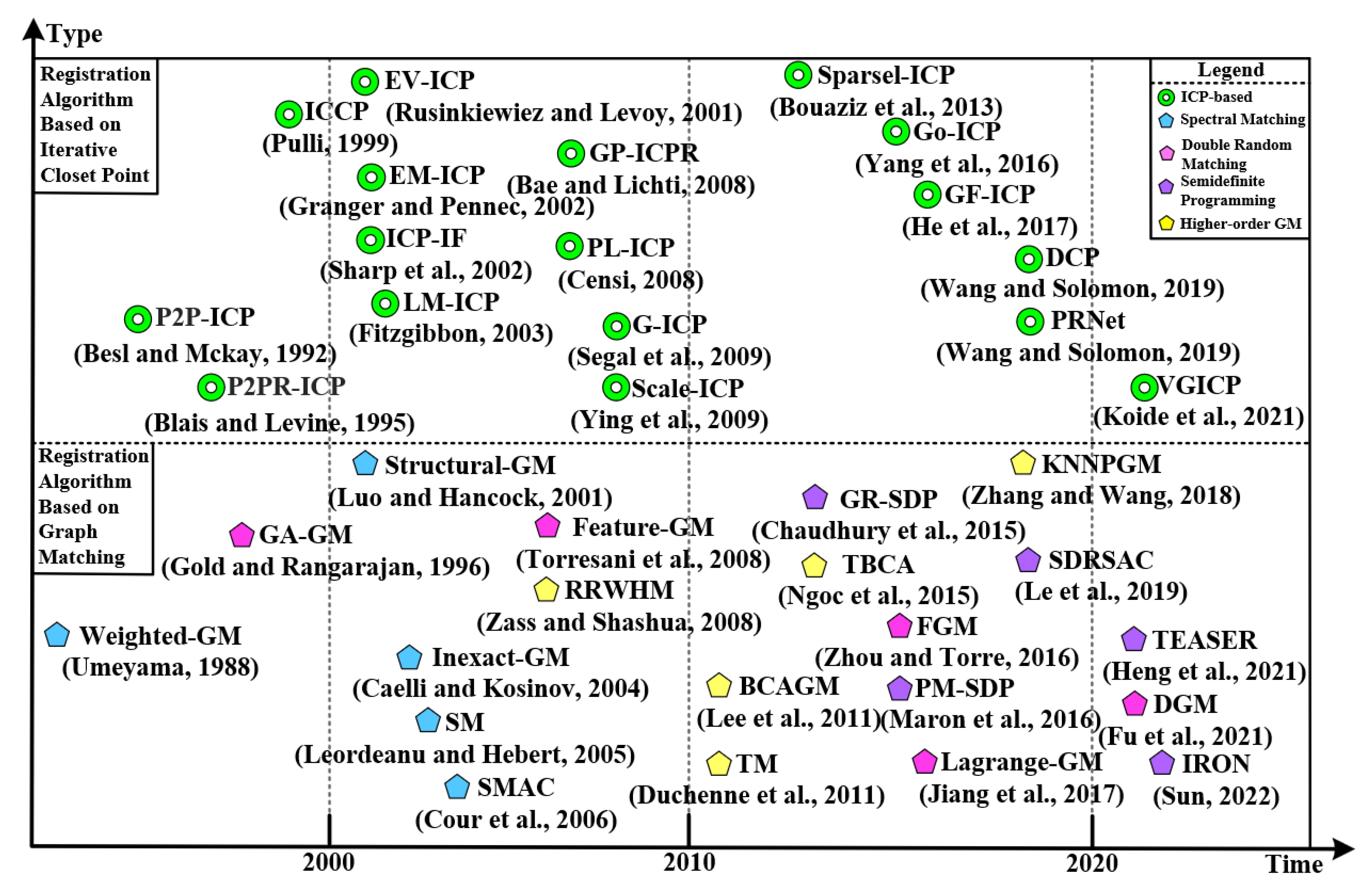



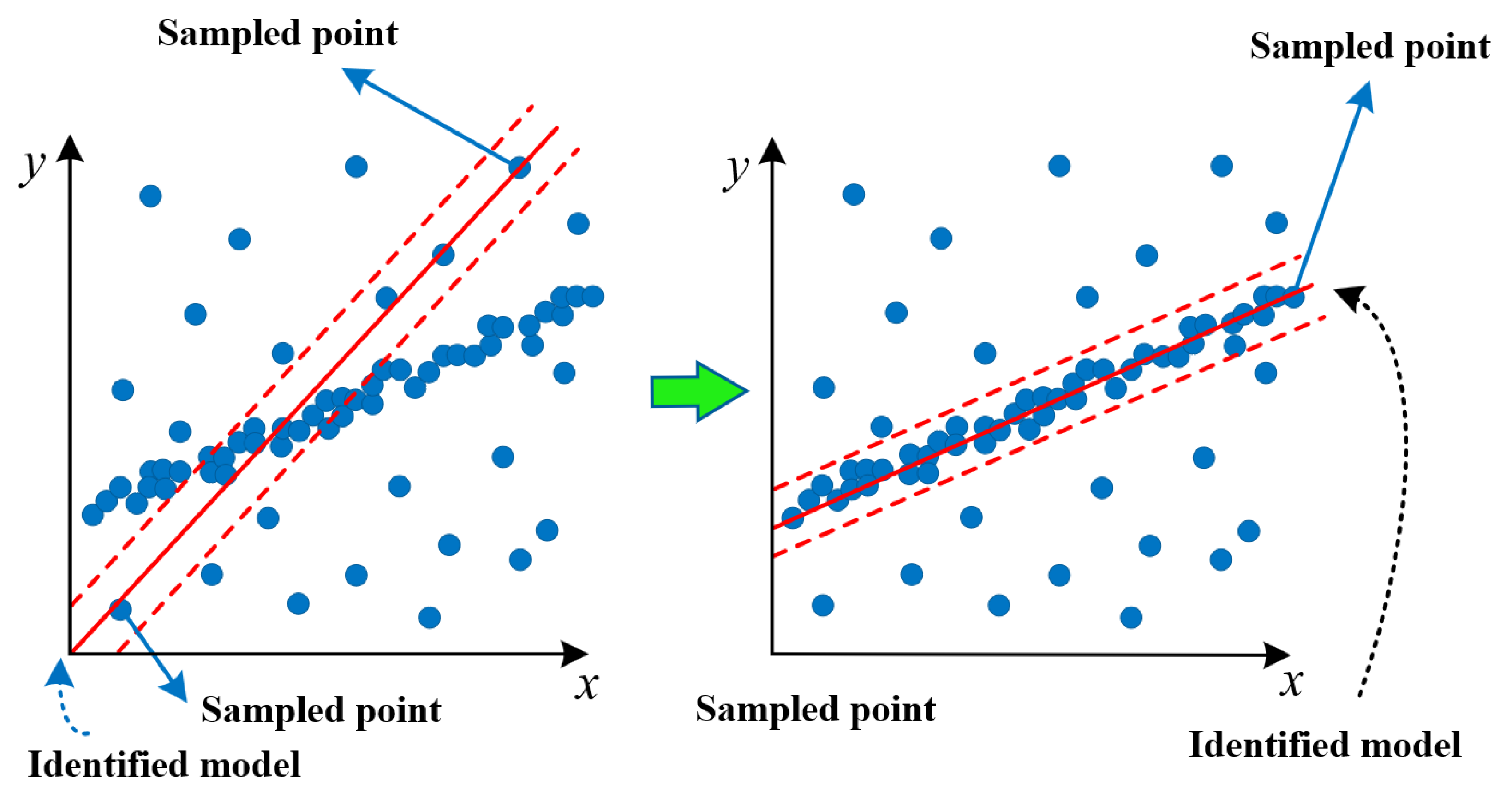
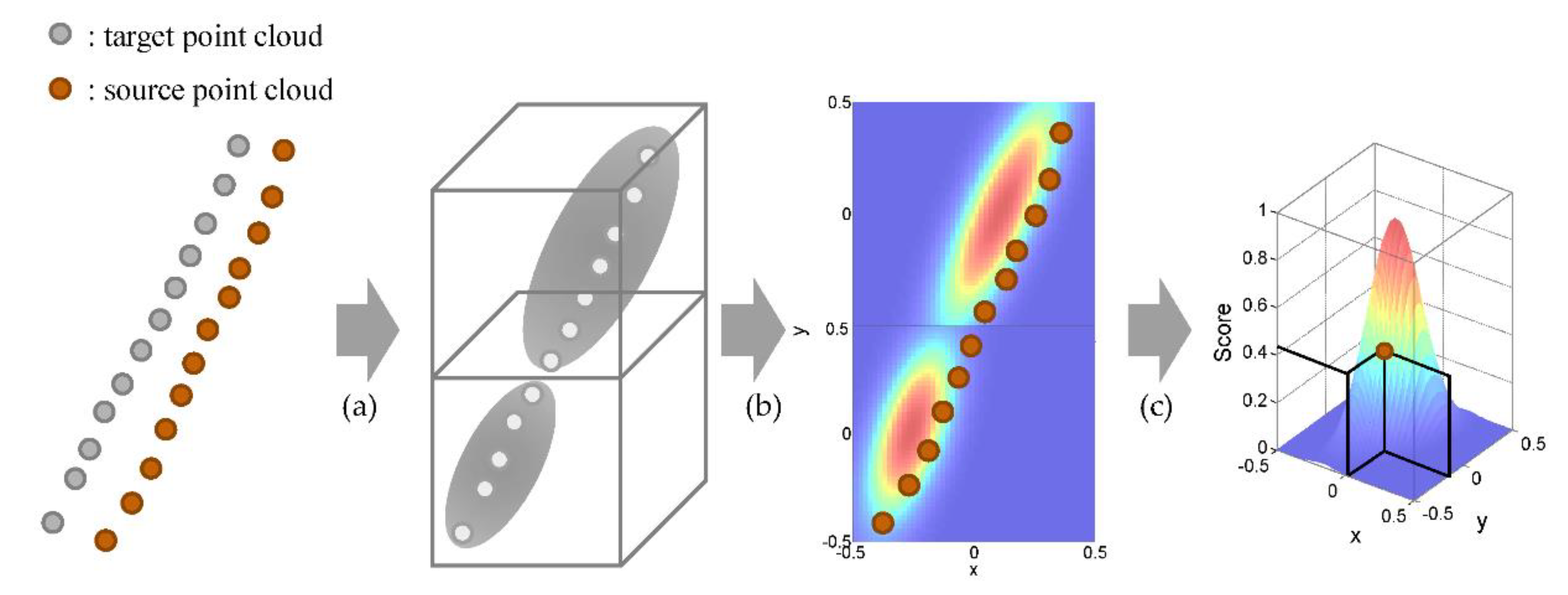
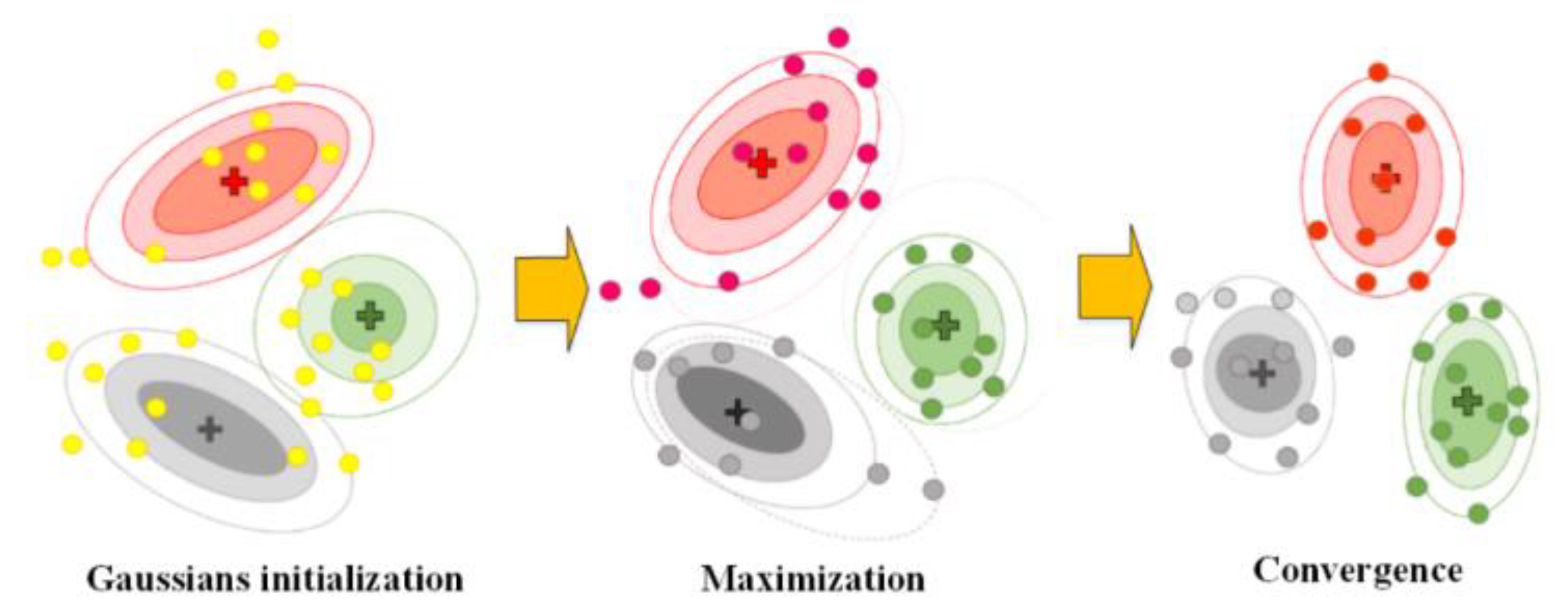
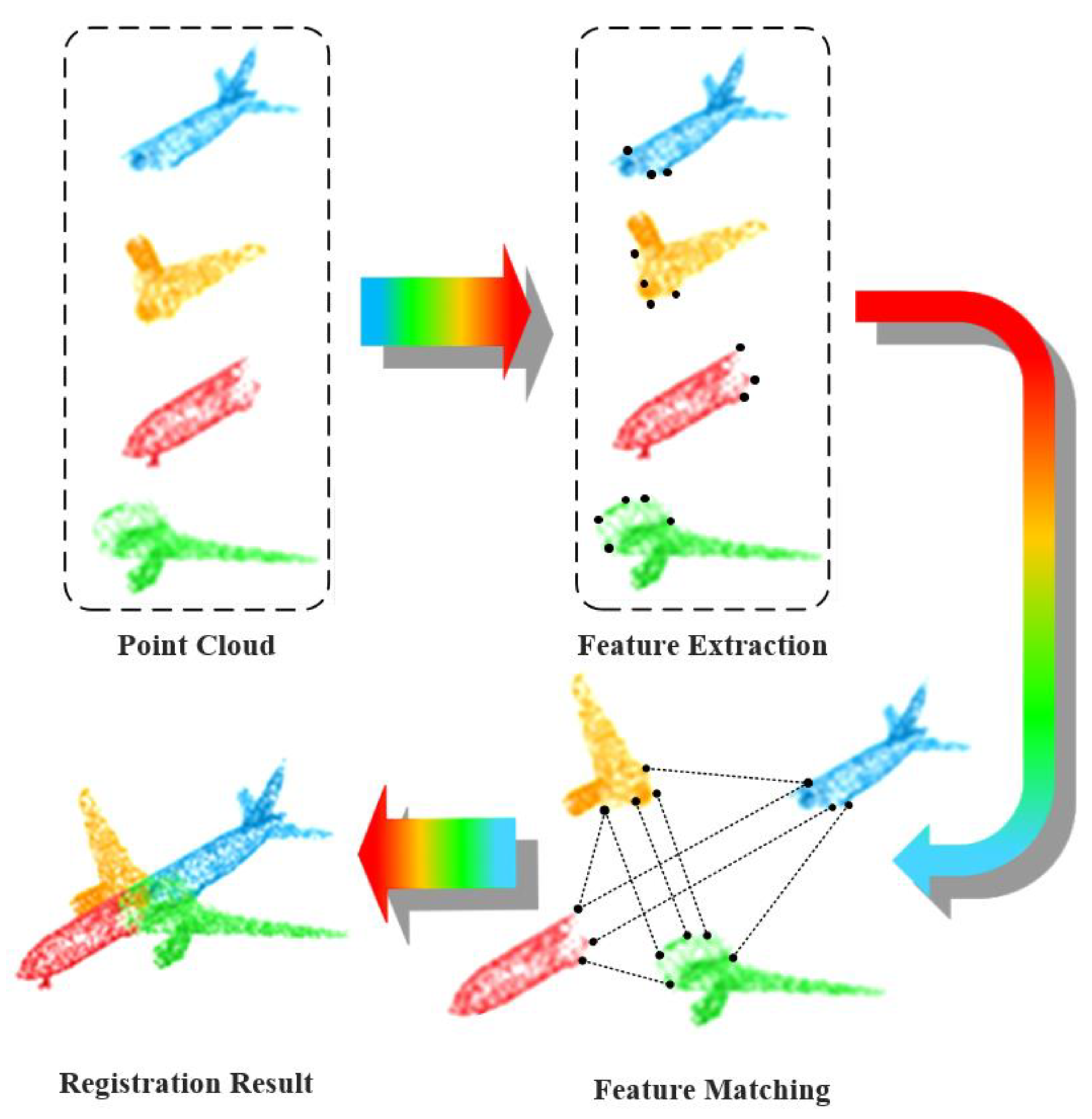
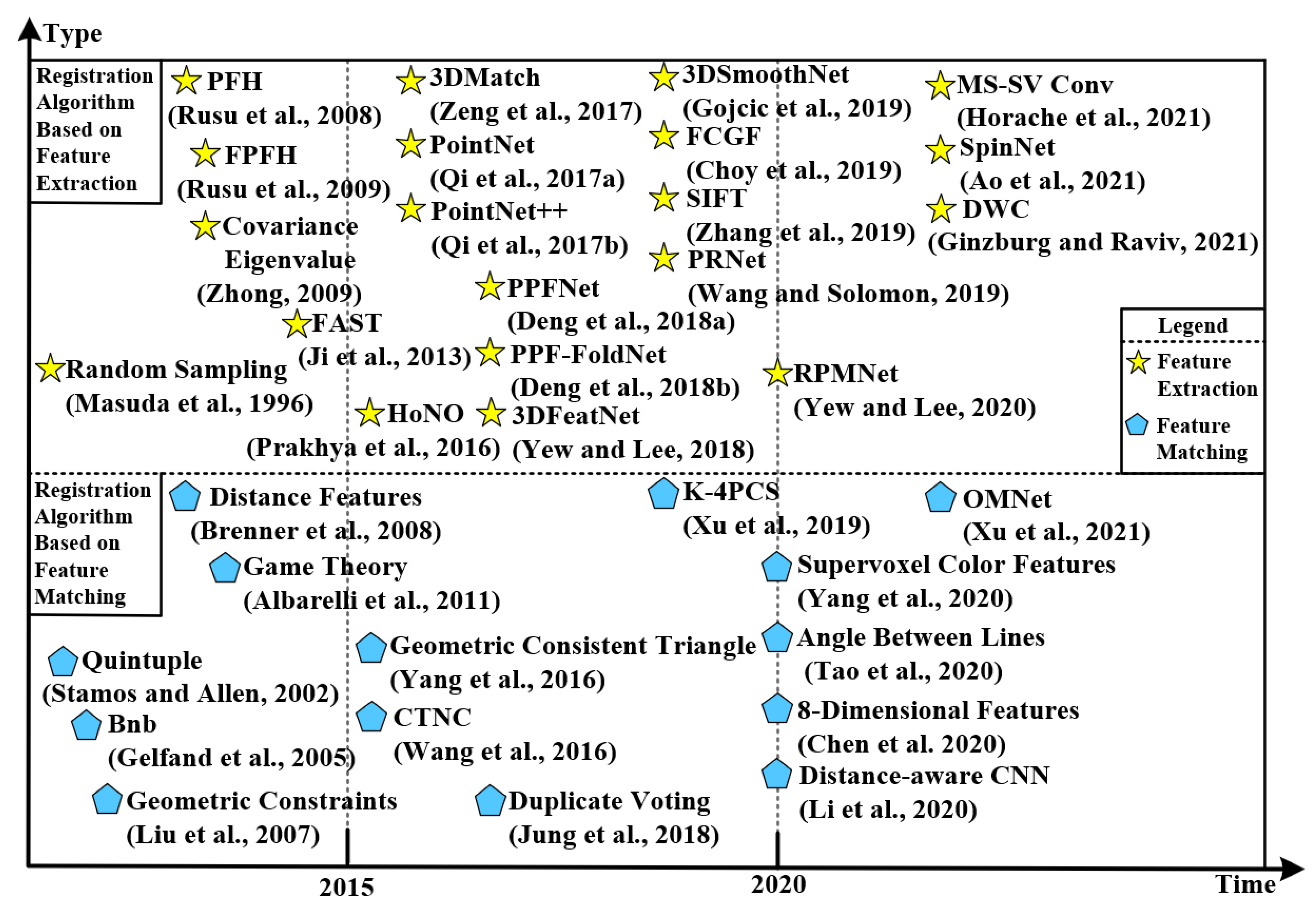

| Classifications | Typical Algorithms | Author | Year | Strengthens | Weaknesses |
|---|---|---|---|---|---|
| Iterative Closet Point (ICP)-Based | P2P-ICP [31] | Besl and McKay | 1992 |
|
|
| Scale-ICP [39] | Segal et al. | 2009 | |||
| Sparsel-ICP [41] | Bouaziz et al. | 2015 | |||
| GF-ICP [43] | He et al. | 2017 | |||
| DCP [44] | Wang and Solomon | 2019 | |||
| VGICP [46] | Koide et al. | 2021 | |||
| Graph Matching (GM)-Based | SM [50] | Leordeanu and Hebert | 2005 |
|
|
| TM [63] | Duchenne et al. | 2011 | |||
| FGM [54] | Zhou and de la Torre | 2016 | |||
| SDRSAC [59] | Le et al. | 2019 | |||
| DGM [56] | Fu et al. | 2021 | |||
| IRON [61] | Sun | 2022 |
| Classifications | Typical Algorithms | Author | Year | Strengthens | Weaknesses |
|---|---|---|---|---|---|
| Random Sample Consensus (RANSAC)-Based | RANSAC [72] | Fischler and Bolles | 1981 |
|
|
| NAPSAC [73] | Myatt et al. | 2002 | |||
| SC-RAMSAC [79] | Sattler et al. | 2009 | |||
| Super-4PCS [78] | Mellado et al. | 2015 | |||
| SC-PROSAC [76] | Ma et al. | 2021 | |||
| RANSIC [83] | Sun | 2021 | |||
| Normal Distribution Transform (NDT)-Based | 2D-NDT [84] | Biber | 2003 |
|
|
| ML-NDT [86] | Cihan and Hakan | 2011 | |||
| SRG-NDT [88] | Das et al. | 2014 | |||
| VSV-NDT [89] | Lu et al. | 2015 | |||
| HANDT [90] | Hong and Lee | 2016 | |||
| SE-NDT [91] | Zaganidis et al. | 2018 | |||
| Gaussian Mixture Model (GMM)-Based | GMM [93] | Jian and Vemuri | 2005 |
|
|
| CPD [92] | Myronenko and Song | 2010 | |||
| JRMPC [94] | Evangelidis et al. | 2014 | |||
| CH-GMM [95] | Fan et al. | 2016 | |||
| HGMR [98] | Eckart et al. | 2018 | |||
| Deep GMR [99] | Yuan et al. | 2020 |
Publisher’s Note: MDPI stays neutral with regard to jurisdictional claims in published maps and institutional affiliations. |
© 2022 by the authors. Licensee MDPI, Basel, Switzerland. This article is an open access article distributed under the terms and conditions of the Creative Commons Attribution (CC BY) license (https://creativecommons.org/licenses/by/4.0/).
Share and Cite
Si, H.; Qiu, J.; Li, Y. A Review of Point Cloud Registration Algorithms for Laser Scanners: Applications in Large-Scale Aircraft Measurement. Appl. Sci. 2022, 12, 10247. https://doi.org/10.3390/app122010247
Si H, Qiu J, Li Y. A Review of Point Cloud Registration Algorithms for Laser Scanners: Applications in Large-Scale Aircraft Measurement. Applied Sciences. 2022; 12(20):10247. https://doi.org/10.3390/app122010247
Chicago/Turabian StyleSi, Haiqing, Jingxuan Qiu, and Yao Li. 2022. "A Review of Point Cloud Registration Algorithms for Laser Scanners: Applications in Large-Scale Aircraft Measurement" Applied Sciences 12, no. 20: 10247. https://doi.org/10.3390/app122010247





